Showing top 0 results 0 results found
Showing top 0 results 0 results found

Chatbot names help you differentiate one bot from another. Your site can have multiple bots: one for sales, one for customer support – the choice is yours. And if you decide to name your customer service bot, it also helps to humanize it.
Statistics show that:
Why should you give your chatbot a name? What are some creative bot names you could try? Is giving your customer service bot a human name a good idea?
We're going to share everything you need to know to name your bot – including examples.
Why give your chatbot a name?
A chatbot name will give your bot a level of humanization necessary for users to interact with it. If you go into the supermarket and see the self-checkout line empty, it’s because people prefer human interaction.
Naming your chatbot provides your bot with a name that:
- gives your customers something they can refer to like they do with humans,
- reinforces the bot’s identity,
- promotes a sense of a real conversation.
A name helps users connect with the bot on a deeper, personal level.
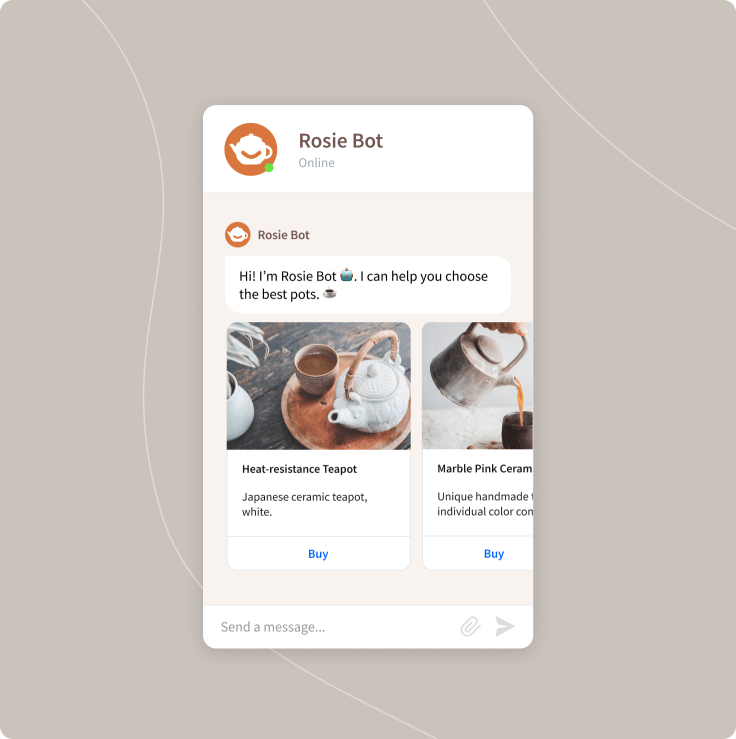
Imagine that you go to your favorite pizza place’s website and the name of the bot says, “live chat.” Visitors will be disappointed when the bot uses AI and there’s no live person. Instead, if the name was Delivery Bot, you would expect the bot to offer:
- information on service areas,
- estimated delivery times,
- ETA for your delivery.
Plus, instead of seeing a generic name say, “Hi, I’m Bot,” you’ll be greeted with a human name, that has more meaning. Visitors will find that a named bot seems more like an old friend than it does an impersonal algorithm.
Makes it clear it’s a bot
If you name your bot “John Doe,” visitors cannot differentiate the bot from a person. Speaking, or typing, to a live agent is a lot different from using a chatbot, and visitors want to know who they’re talking to. Transparency is crucial to gaining the trust of your visitors.
Visitors should know they’re talking to a bot because:
- Bots make errors, but human error is seen as incompetence and can tarnish your company’s reputation.
- People may prefer to use the bot or find another contact method to speak to a human.
- Frustration in the support process is lower when the visitor knows who they’re speaking with.
Ecommerce stores must make it abundantly clear, through the name of the bot, who the visitor is talking to: live chat or a chatbot. Otherwise, you risk frustrating the customer and potentially losing a sale.
Take ChatBot for a test drive with a free 14-day trial.
Create instant connections
Consumers appreciate the simplicity of chatbots, and 74% of people prefer using them. Bonding and connection are paramount when making a bot interaction feel more natural and personal.
Naming your bot with a non-descriptive or trusting name can cause more harm than good. For example, these are poor names to give a bot:
- Robot123
- AI Bot
The name of your chatbot should play on the user’s emotions to build trust and customer relationships, and increase customer satisfaction. For example:
- Happy Customer Service
- Rapid Response Team
Customers reach out to you when there’s a problem they want you to rectify. Fun, professional, catchy names and the right messaging can help.
Offers natural conversations
You want your website’s visitors to forget that they’re chatting with a bot. While convenient and able to resolve issues rapidly, bots are often robotic and have unnatural conversations. Imagine if your website visitor is greeted with:
- “I’m XYZ’s AI Bot. I use LLMs and advanced queries to parse your text and algorithms to provide the best answers.”
Many of your visitors would be left scratching their heads because they have no idea what an LLM is or what you mean by advanced queries. Instead, you can have a message that feels more natural and promotes conversation, such as:
- “I’m SuperSupport. I’m here to help you resolve customer service issues in seconds – not minutes. Ask me any questions you like.”
If you have a simple chatbot name and a natural description, it will encourage people to use the bot rather than a costly alternative. Something as simple as naming your chatbot may mean the difference between people adopting the bot and using it or most people contacting you through another channel.
At this point, you know that naming your bot has many advantages. But how do you name it?
How to name a chatbot
Naming a chatbot is a crucial part of the whole customer engagement journey. You'll be able to reach users at new touchpoints and create a memorable experience for your visitors. Since you’ve likely never named a chatbot before, where do you even begin?
We recommend following a five-step process before deciding on chatbot names.
Step 1: Define the bot’s purpose
Your bot has a purpose. What is it? If you don’t know the purpose, you must sit down with key stakeholders and better understand the reason for adding the bot to your site and the customer journey.
Ask stakeholders questions, such as:
- What's the purpose of the bot?
- Will the bot answer questions?
- Will the bot resolve complaints?
- Will the bot offer solutions?
- Will the bot upsell or cross-sell?
It wouldn’t make much sense to name your bot “AnswerGuru” if it could only offer item refunds. The purpose for your bot will help make it much easier to determine what name you’ll give it, but it’s just the first step in our five-step process.
Step 2: Pinpoint your target audience’s profile
Who is your target audience? Demographics don’t help as much when choosing a chatbot name because, in the online world, you have to think about:
- region,
- language,
- preferences,
- age.
If you use Google Analytics or something similar, you can use the platform to learn who your audience is and key data about them. You may have different names for certain audience profiles and personas, allowing for a high level of customization and personalization.
You want to design a chatbot customers will love, and this step will help you achieve this goal.
Step 3: Match the name to your brand identity
Your brand is unique. Your chatbot name needs to match. You know your brand’s identity better than anyone. Consider what your company:
- represents,
- stands for,
- wants to be seen as.
If you want, your name can relate to your industry.
Step 4: Make the difficult decision of a human or bot name
Certain bot names can sound like human names or like a bot, and you should choose wisely. You may want to consider:
- gender neutral names,
- bot names that are fun.
If you choose a direct human to name your chatbot, such as Susan Smith, you may frustrate your visitors because they’ll assume they’re chatting with a person, not an algorithm. You want to be discerning with your chatbot name.
When you add welcome text to the bot, be sure that you incorporate text explaining that the person is talking to a chatbot and how it can help them.
Step 5: Choose the “gender” of your bot.
Bots are not really people, so why consider gender? Studies show that bot users prefer female names. Why? Perhaps people feel more comfortable speaking to women. You can also opt for a gender-neutral name, which may be ideal for your business.
Chatbots are advancing, and with natural language processing (NLP) and machine learning (ML), we predict that they’ll become even more human-like in 2024 than they were last year. Naming your chatbot can help you stand out from the competition and have a truly unique bot.
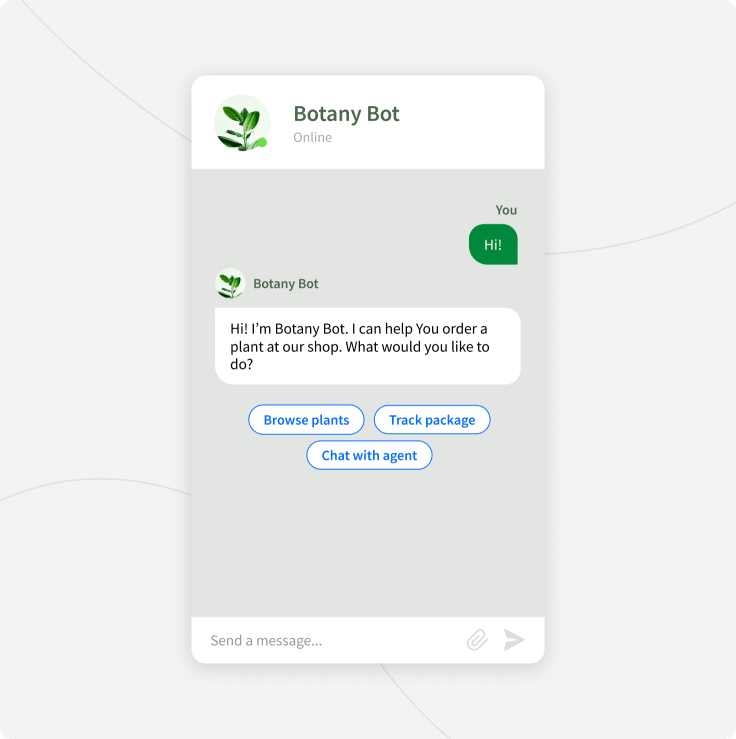
Examples of interesting chatbot name ideas
What can you name your chatbot? Anything. If you want a few ideas, we’re going to give you dozens and dozens of names that you can use to name your chatbot.
Catchy chatbot names
- ChatterPal Pro
- ByteBot Concierge
- CleverQuery
- IntelliChat Pro
- EchoSphere Assistant
- InsightfulBot Connect
- MindBridge AI
- ZenithChat.ai
- ByteSage
- PinnaclePal Pro
Good bot names
- TalkTact Pro
- MindfulMate Assistant
- SynapseSphere Concierge
- SmartServe.ai
- InsightIQ Chatbot
- SavvySphere Assistant
- DialogueDyno Bot
- OmniGuide AI
- ClarityCraft Bot
- ApexAssist Pro
Creative bot names
- Intellibot
- OmniAIHub
- ConvoCrafters
- EmpaNexa
- QuantumQuola
- MindfulAI
- TechTactBot
- EvolveEchoes
- ProwessPalaver
- InsightSage
Cool bot names
- Quantum.ai
- CortexConvo
- ZenithBot
- PinnaclePulse
- SynthzSphere
- ProChatBot
- ElysiaEcho
- ApexAssistant
- StellarScribe
- CypherPal
Funny bot names
- Witty Watson
- AMA.ai
- Punny Pundit
- Sherlock Solves
- The Chatty Canary
- Convo Connoisseur
- HelpBot Houdini
- Quipster Q&A
- Brainiac Buddy
- GiggleGuru
AI bot names
- Nexusx
- Sparky
- Cypherus
- MuseAI
- Nomad.Bot
- Acumen
- Equinox.ai
- Zephyr
- Enigma
Male bot names
- Xethan
- Nexon
- Olyvyr
- Jaxonix
- Neotron
- Aidenix
- Luminos
- Matrix
- Caelus
- Synthera
Female AI names
- Xenara
- Novara
- Astraia
- Elara
- Novaelyn
- Zephyra
- Cyra
- Seraphis
- Lysandra
- Quantumia
Virtual assistant names
- Willow Wisp
- MuseBot
- Zenon
- Merlin
- Iris
- Chronos
- SkyGuide
- Quiply
- Optima
- Ember
HR chatbot names
- BeneBot
- Talent.ai
- OnboardMeBot
- AskHR
- Polly Perks
- BridgeBot
- HRAssistant.ai
- HireHero
Chatbot names for banking
- Coin Captain
- Penny Pincher
- Fund Finder
- VaultBot
- ProsperBot
- Moolah Mentor
- Ledger Lad
- Interest Genie
- Budget Buddy
- FinWiz
Cute names for chatbots
- Chatty Chipmunk
- HappyHelper.ai
- Spark Sprite Bot
- Curious Kitten
- Gigglebot
- Rainbow Pal
- Sneaky Snail
- Wise Wisp
- Fuzzy Bot
- Clever Cricket
Music bot names
- Melody.ai
- Harmony Hub
- Beat Buddy
- Tune Taylor
- Rhythm Rocket
- Groove Guru
- Amplify Ally
- DJ Dynamo
- Soundtrack Sensei
- Chorus Conductor
- Lyric Lama
- Remix Reactor
Bot names representing the business
- AllyAI
- Insight Engine
- Companion Chat
- ROI Compass
- GuideAI
- SparkBuddy
- Bridge.ai
- Lead Muse
- AskABot
- HelpfulHubAI
- Concierge.AI
You can also use names that are relevant to your own or brand's personality. For example, if your business name is Synirgistics, your bot's name could be “Synirgistics.ai” or “Synirgistics.bot.”
Business bot name ideas
- Brightidea Bot
- AssistAI
- Helper.ai
- Data Dynamo
- Customer Champion
- HelpCraft
- Brainstorm Buddy
- KnowBot
- SalesBot.ai
- AskAssist
- IntelliQ
- Lead Genie
Robotic name ideas for chatbot
- Cognit
- NexusGenux
- A.I.in
- Cipher
- NanoBot
- SynapseSpark
- Quantata
- Blink
- EcoBot
- CircuitBreaker
- Bionic Bo
- Pixel Pal
Interesting chatbot names
- MuseNet
- Wit Weaver
- Quipster Codex
- Enigma Engine
- StorySpinner
- The Fixer
- Galaxy Guide
- Ask Alana
- Insightful Cipher
Technical chatbot names
- Glitch Gremlin
- Cyber Scribbler
- Code Sage
- Algorithmic Al
- Quantum Quinn
- Firewall Synapse
- Silicon Phoenix
- Byte Buddy
Industry-specific chatbot names
Chatbots can also be industry-specific, which helps users identify what the chatbot offers. You can use some examples below as inspiration for your bot’s name.
Startups
- Sproutling Spark
- Launchpad Luna
- Brainstorm Bolt
- StartupHero
- VentureVanguard
- Lead Link
- Growth Guru
- EngagementEngine
- Scale Sensei
Ecommerce
- ShopSavvy
- FindIt
- CartGenie
- StyleScout
- RecommendRobo
- VIPBot
- DealDash
- WishlistGenius
- ThriftyBot
Software
- WiseGuide
- AssistEngine
- SparkBot
- Navigator.ai
- ConciergeBot
- Empower Bot
- Workflow Whisperer
- CodeBot
- SoftwareConcierge
Automotive
- Gear Genie
- Engine Whisperer
- AutoBot
- Road Robin
- Service Sphinx
- AutomotiveAce
- Car Care Concierge
- Service Sentinel
Education
- Socrates
- Quizmaster Pal
- Professor Aristotle
- Knowledge Seeker
- Eureka Engine
- Discovery Dynamo
- Insightful Indigo
- Learning Louie
- Study Buddy
Healthcare
- VitaBot
- VirtuaMed
- PulsePoint
- HealBot
- Sympathi
- ReGen
- RxPal
- HealthSpring
- Kinetix
- BloomBot
Travel
- Globetrotter Genie
- Wanderlust Whisperer
- GlobeWeaver
- Horizon Seeker
- Winged Itinerary
- Flight Finder Phoenix
- Thrill Architect
- Adventure Ally
- Mementi Momento
- Nomad Nook
Finance
- Mint Mastermind
- Penny Alchemist
- Smart Cents Pro
- Debt Dojo
- Portfolio Pathfinder
- Yield Accelerator
- SpendSense
- Crypto Compass
- TaxBuddy
- FinFit Forge
Web hosting
- Domain Foundry
- Pixel Forge
- Web Sentinel
- Searchlight Strategies
- Velocity Engine
- Analytics Illuminator
- Seamless Transitions
- Scalability Sphinx
- Skybridge Bot
Sales
- Lead Magnet
- Deal Dynamo
- Sales Whiz
- Pipeline Pro
- Prospector Phoenix
- Proposal Pal
- Upsell Unicorn
- The Great Negotiator
Real estate
- Key Finder
- House Maven
- Mortgage Maestro
- Listing Lion
- Neighborhood Navigator
- Open House Owl
- Refi Rocket
- Property Navigator
- Equity Expert
What are some bad bot names?
The example names above will spark your creativity and inspire you to create your own unique names for your chatbot. But there are some chatbot names that you should steer clear of because they’re too generic or downright offensive.
Here are some bad bot name examples:
- RoboCop AI: Names with “robo” or “cop” can create an image of surveillance or control.
- Chatty Kathy: Although catchy, this name is unprofessional and can have negative connotations.
- The Answer Machine: A name like this is too generic. Make sure you inject some personality into your chatbot’s name and make it relevant to your brand or industry.
- FriendBot: Another generic name that may also imply your bot is more friend-like than helpful.
As a general rule of thumb, you want to avoid using names that are:
- Offensive. Using insensitive or discriminatory language will alienate your audience and tarnish your reputation.
- Too similar to your brand name. Your chatbot’s name can certainly be relevant to your brand, but if it’s too similar, you may confuse your audience.
Chatbot names should be creative, fun, and relevant to your brand, but make sure that you’re not offending or confusing anyone with them. Choose your bot name carefully to ensure your bot enhances the user experience.
Use an AI name generator
Are you having a hard time coming up with a catchy name for your chatbot? An AI name generator can spark your creativity and serve as a starting point for naming your bot.
There are many name generators out there, but if you want more creative control, we recommend trying ChaptGPT or Gemini.
When generating names, provide some key information, such as:
- your industry,
- the purpose of your bot (customer service, product recommendations, etc.),
- your preferred tone (professional, friendly, funny, etc.) or any language you’d like to avoid.
Gemini has an advantage here because the bot will ask you for specific information about your bot's personality and business to generate more relevant and unique names.
You can refine and tweak the generated names with additional queries.
What if you just want a quick and easy name generator? You have plenty of options here, too, including:
- HootSuite’s AI name generator. It’s meant for generating business names, but if you add the “chatbot” keyword to your description, it will create relevant name ideas.
- BrandCrowd, which allows you to choose the style and length of your name.
- Namelix, which is also meant for generating business names. With the right keywords, you can use this tool to generate some fun and unique names for your bot.
Name generators like the ones we’ve shared above are great for inspiring your creativity, but tweak the names to make them your own.
Top ecommerce chatbots
You have the perfect chatbot name, but do you have the right ecommerce chatbot solution? The best ecommerce chatbots reduce support costs, resolve complaints and offer 24/7 support to your customers.
Here are some of the top solutions out there:
ChatBot
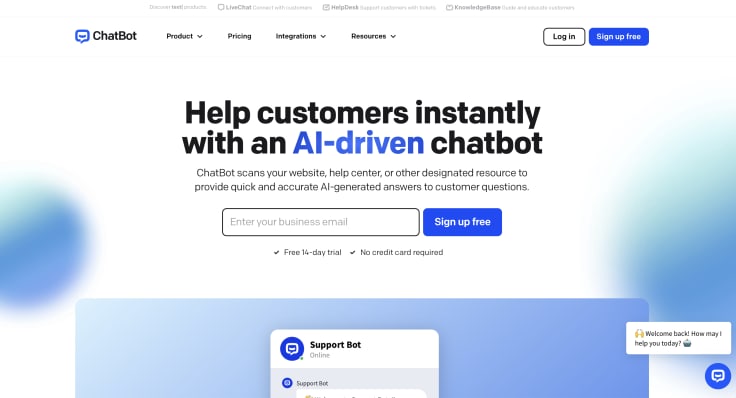
ChatBot delivers quick and accurate AI-generated answers to your customers' questions without relying on OpenAI, BingAI, or Google Gemini. You get your own generative AI large language model framework that you can launch in minutes – no coding required.
ChatBot can be trained by help centers, websites, text documents and more. Turn your training sources on and off with the tap of a button.
All of your data is processed and hosted on the ChatBot platform, ensuring that your data is secured.
ChatBot makes it easy to engage with your visitors by offering quick responses and personalized greetings. And the platform integrates with the tools you’re already using, including:
- Shopify
- LiveChat
- HelpDesk
- Facebook Messenger
- Slack
- WordPress
- Zendesk
ChatBot covers all of your customer journey touchpoints automatically.
Standout features
- Drag-and-drop builder with no coding experience required.
- Chatbot templates to personalize.
- Launch and reuse stories with ease.
- Design your bot to align with your brand’s style and image.
- Collect data to create more personalized user experiences.
ChatBot’s AI resolves 80% of queries, saving time and improving the customer experience.
Take ChatBot for a test drive with a free 14-day trial.
Tidio

Tidio’s AI chatbot incorporates human support into the mix to have the customer service team solve complex customer problems. But the platform also claims to answer up to 70% of customer questions without human intervention.
Tidio relies on Lyro, a conversational AI that can speak to customers on any live channel in up to 7 languages.
Their plug-and-play chatbots can do more than just solve problems. They can also recommend products, offer discounts, recover abandoned carts, and more.
Features
- Use canned responses, collect client data before chatting, and more.
- Integrates with Shopify, WordPress, Zendesk, MailChimp, Hootsuite, and more
- Visual chat builder.
- Options to handle ticketing and order management
Tidio is simple to install and has a visual builder, allowing you to create an advanced bot with no coding experience.
Snatchbot
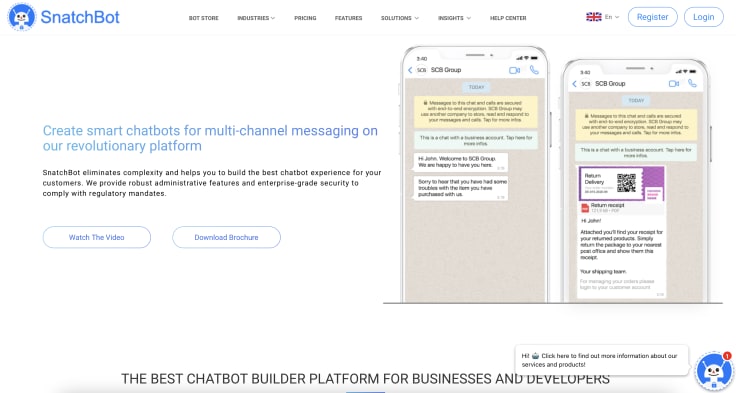
Snatchbot is unique because it requires a more intense training process than other options on our list. Offering state-of-the-art NLP, the bot continues to learn from multiple resources:
- Voice
- Multi-language
- Data extraction
- Machine learning
Features
- Geo-localization.
- Translation.
- Text-to-speech.
- Conversation history.
Snatchbot is robust, but you will spend a lot of time creating the bot and training it to work properly for you. If you’re tech-savvy or have the team to train the bot, Snatchbot is one of the most powerful bots on the market.
You can also add plugins to extend your bot’s features.
But, you’ll notice that there are some features missing, such as the inability to segment users and no A/B testing.
ManyChat
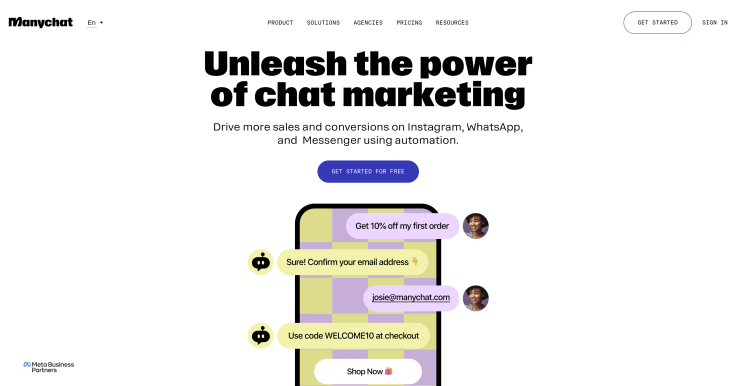
ManyChat is an automation bot that helps you use chat marketing to increase sales. A lead can ask the bot for a discount, and with your rules in place, you can have the bot:
- request the person’s email address,
- send a discount code.
It's that simple.
Features
- Instagram integration.
- WhatsApp integration.
- Facebook integration.
- Pre-made templates.
- Bot-to-home interactions.
- Sales and return support.
- Challenges, quizzes, and other giveaway options.
ManyChat offers templates that make creating your bot quick and easy. While robust, you’ll find that the bot has limited integrations and lacks advanced customer segmentation.
Involve your team in brainstorming chatbot name ideas
Chatbot names give your bot a personality and can help make customers more comfortable when interacting with it. You'll spend a lot of time choosing the right name – it's worth every second – but make sure that you do it right.
You want to choose a name that is catchy and descriptive.
If you have a marketing team, sit down with them and bring them into the brainstorming process for creative names. Your team may provide insights into names that you never considered that are perfect for your target audience.
Take ChatBot for a test drive with a free 14-day trial.



